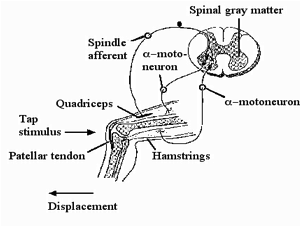Reflex arcA reflex should be distinguished from an action as it is a stereotyped response or movement (e.g., an eye blink to a specific external stimulus such as a puff of air) involving little or no cortical mediation. As such, it lacks the hallmark features of an action such as motor equivalence, which allow movements to be organised in a flexible and variable way to achieve a particular outcome in a particular task. Moreover, reflexes lack intentionality, whether it be an intentional act or an intentional sign. The above represents a reflex originally described by Sherrington. Robert Whytt (1714-1766) is usually credited with discovering the spinal reflex. Typically, three general classes of reflexes are distinguished: purely somatic (e.g., knee-jerk reflex) in which only afferent and efferent pathways of the somatic nervous system are involved, purely autonomic (e.g., salivary reflex) involving only afferents and efferents of the autonomic nervous system in controlling the secretion of glands, and mixed somatic and autonomic (e.g., respiratory responses to raise or lower blood gas levels). It is important to distinguish a reflex in this sense (i.e., as automatic and lacking conscious volition) from reflexes in Piagetian and neo-Piagetian theory. In the latter instances, they are more molar units of behavior over which infants exert some cortical control and constitute the first level of development. Examples include sucking, the palmar grasp, and looking at a seen object.
